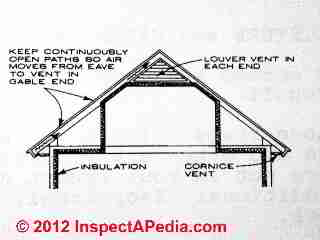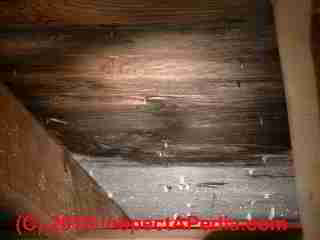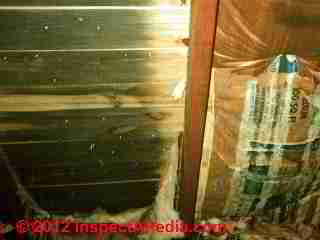 Cape Cod Roof Venting or Dense Insulation Designs
Cape Cod Roof Venting or Dense Insulation Designs
Suggestions for ventilated or un-vented roofs on Cape Cod type structures
- POST a QUESTION or COMMENT about un-vented cathedral ceiling under-roof spaces in cape cod style homes
Cape cod roof insulation & venting: Hot roof designs, aka dense-packed insulated sloped roofs or ventilation designs for cape cod style buildings.
This article series describes various solutions for the un-vented or insulated portions of cape cod home roofs or ceilings or for similar under-roof spaces. The article offers advice on how to avoid condensation, leaks, attic mold, & structural damage when roof venting is not possible.
We provide data & design suggestions for cape cod home hot roof designs or for providing a cape cod style structure with roof and ceiling ventilation for this hard-to-vent roof design.
InspectAPedia tolerates no conflicts of interest. We have no relationship with advertisers, products, or services discussed at this website.
- Daniel Friedman, Publisher/Editor/Author - See WHO ARE WE?
Special Venting (or "packed" hot roof) Problems for Cape Cod Roofs
 Cape cod roofs present a special problem in that in the usual cape design there is a lower attic knee-wall enclosing what amounts to a "low attic"
Cape cod roofs present a special problem in that in the usual cape design there is a lower attic knee-wall enclosing what amounts to a "low attic"
followed by the equivalent of a cathedral ceiling over the middle section of the roof, often penetrated by dormers when the second floor of the
Cape Cod is designed to be occupied, followed again by an attic design for the upper third of the roof.
When I examine Cape Cods built in the Northeastern U.S. in winter, homes built in the 1930's through 1960's especially show ice dams on the lower roof, snow on the center roof, and all snow melted off of the upper third of the roof.
Those conditions mean leaks into the building walls, unnecessary heat losses (higher heating costs), and too often roof sheathing and insulation contaminated with several genera of mold.
And where we have removed insulation from between the rafters of such roofs we often find moisture has been trapped against the roof sheathing.
Sometimes that has led to mold, delaminating plywood sheathing, or even rot.
In new construction we have an opportunity for better building design, implementation, and energy performance.
The bottom line (in my opinion) is that roofers and builders who like the "hot roof" approach trust their implementations of the hot roof approach and assert that it works fine but water or moisture leaks from either outside or from within the building into an un-vented building cavity (like a cathedral ceiling roof) cause more damage than leaks into a vented roof.
Watch out: when enthusiasts recount differences between the performance of a "packed" or "hot roof" design (presumably very high-R and "tight") and a ventilated roof design (more trouble, more cost, sometimes poorer insulation and higher energy cost) they sometimes may not have realized, or may fail to report that when a leak into the packed roof occurs, water stays there a long time - inviting rot, carpenter ants, mold. The result is a very large repair expense.
Steven Bliss offers a final warning on Hot Roof Designs:
I agree with you that, in the real world, this is not such a good idea. If there's a flashing leak or other roof leak, you could have a pretty soggy mess that stays wet for a long time and could cause structural decay.
Plenty of people are building hot roofs, but I wouldn't -- except maybe one with spray urethane which won't absorb much water like cellulose would. [37]
...
Continue reading at HOT UN-VENTED ROOF DESIGN SOLUTIONS or select a topic from the closely-related articles below, or see the complete ARTICLE INDEX.
Or see these
Recommended Articles
- INSULATION LOCATION - WHERE TO PUT IT - home
- ATTIC CONDENSATION CAUSE & CURE
- ATTIC INSULATION MISSING
- ATTIC INSULATION LOCATION & QUANTITY
- ATTIC MOISTURE or MOLD INSPECTION
- ATTIC VENTILATION
- BASEMENTS & CRAWLSPACE INSULATION LOCATION
- CAPE COD ROOF & KNEE WALL INSULATION & VENTILATION
- CAPE COD ROOF VENT or DENSE PACK INSULATE
- CATHEDRAL CEILING INSULATION
- CATHEDRAL CEILING VENTILATION
- FRAMING DETAILS for BETTER INSULATION
- HOT UN-VENTED ROOF DESIGN SOLUTIONS
- INSULATE ROOF with DENSE PACKING
- ROOF VENTILATION SPECIFICATIONS for details.
- ROOF VENTILATION NEEDED?
Suggested citation for this web page
CAPE COD ROOF VENT or DENSE PACK INSULATE at InspectApedia.com - online encyclopedia of building & environmental inspection, testing, diagnosis, repair, & problem prevention advice.
Or see this
INDEX to RELATED ARTICLES: ARTICLE INDEX to BUILDING VENTILATION
Or use the SEARCH BOX found below to Ask a Question or Search InspectApedia
Ask a Question or Search InspectApedia
Try the search box just below, or if you prefer, post a question or comment in the Comments box below and we will respond promptly.
Search the InspectApedia website
Note: appearance of your Comment below may be delayed: if your comment contains an image, photograph, web link, or text that looks to the software as if it might be a web link, your posting will appear after it has been approved by a moderator. Apologies for the delay.
Only one image can be added per comment but you can post as many comments, and therefore images, as you like.
You will not receive a notification when a response to your question has been posted.
Please bookmark this page to make it easy for you to check back for our response.
IF above you see "Comment Form is loading comments..." then COMMENT BOX - countable.ca / bawkbox.com IS NOT WORKING.
In any case you are welcome to send an email directly to us at InspectApedia.com at editor@inspectApedia.com
We'll reply to you directly. Please help us help you by noting, in your email, the URL of the InspectApedia page where you wanted to comment.
Citations & References
In addition to any citations in the article above, a full list is available on request.
- In addition to citations & references found in this article, see the research citations given at the end of the related articles found at our suggested
CONTINUE READING or RECOMMENDED ARTICLES.
- Carson, Dunlop & Associates Ltd., 120 Carlton Street Suite 407, Toronto ON M5A 4K2. Tel: (416) 964-9415 1-800-268-7070 Email: info@carsondunlop.com. Alan Carson is a past president of ASHI, the American Society of Home Inspectors.
Thanks to Alan Carson and Bob Dunlop, for permission for InspectAPedia to use text excerpts from The HOME REFERENCE BOOK - the Encyclopedia of Homes and to use illustrations from The ILLUSTRATED HOME .
Carson Dunlop Associates provides extensive home inspection education and report writing material. In gratitude we provide links to tsome Carson Dunlop Associates products and services.


